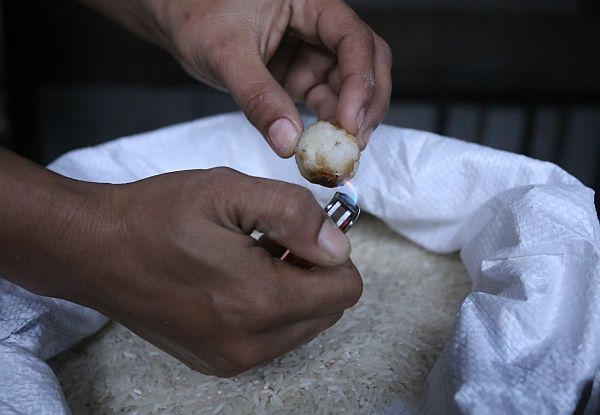
A sample of the alleged fake rice received by a resident of Santa Fe has been declared authentic and real by the National Food Authority.
CDN PHOTO/LITO M. TECSON
THE samples of the alleged fake rice obtained from Santa Fe, Bantayan Island in northern Cebu arrived in Cebu City yesterday morning were tested by the National Food Authority and were found not made from plastic or rubber.
On the contrary, the rice was edible and digestible thus the NFA and the provincial government declared that there is no fake rice present in Cebu province.
However, the reports about two children sent to the municipal health office for consuming the alleged fake rice found in Santa Fe, Bantayan are true.
Authorities are now looking into other factors that lead to the hospitalization of the two children, who were among the beneficiaries of the Pantawid Pamilyang Pilipino Program (4Ps), the recipients of the reported fake rice.
At the Capitol, Acting Cebu Governor Agnes Magpale presented to media yesterday morning 13 packs of rice samples from Santa Fe, distributed by accredited rice traders of the Sustainable Livelihood Program (SLP).
Each of the packs obtained by representatives of the Cebu Provincial Capitol weighed about 500 grams. Some of them were cooked to test if they were indeed edible and real.
“Pag lung-ag namo, wala niuntol (When we cooked it, it did not bounce). This means it’s real.
Supposedly fake but it’s not fake,” said Magpale.
When asked to assess whether they were of low-quality or not, Magpale said the grains are whole and does not have any unusual smell coming from it when cooked.
“In fact, dili siya low quality (it’s not of low quality). We got them from the retailers of the SLP,” Magpale added.
But the acting governor sent a portion of each of the 13 samples to the Department of Agriculture-7 (DA) in Mandaue City for further laboratory tests.
“I will wait for the results from DA to see if these grains are indeed real because we also found out that maybe it’s not the rice after all which lead to the complaints of kalibanga (diarrhea),” she added.
Magpale said they will also check the water supply in Santa Fe, especially that they discovered that the main source of water supply there are deep wells.
“These wells, they may have been contaminated and maybe that’s why some of them are experiencing kalibanga (diarrhea),” she stated.
Meanwhile, according to the NFA, the samples of alleged fake rice from Santa Fe town met the criteria for identifying the physical characteristics of real rice.
These include having chalky, white dust residue, non-uniformity of the grain’s shape, and the presence of ridges or grooves on the surface of a grain.
NFA-7 information officer Olma Marie Bayno told Cebu Daily News they sent the rice samples to the Food Development Center (FDC) for further testing.
“In terms of physical appearance, yes the rice are not fake. But to determine what types of rice they are, and ultimately the cause as to why some were hospitalized upon consuming them, it has to be sent for laboratory examinations since we are only limited to check their authenticity based on their physical characteristics,” she said in a phone interview.
The NFA got more than 13 samples of the supposed fake rice in Santa Fe which came from retailers and several of the beneficiaries.
“Not all rice from all recipients were obtained because they disposed them when these unverified reports of fake rice present in their area were going around,” Bayno clarified.